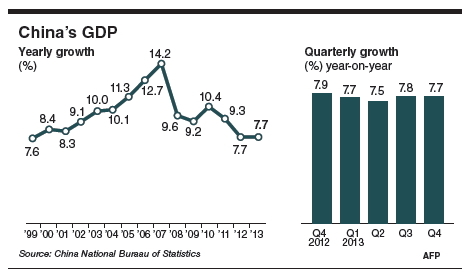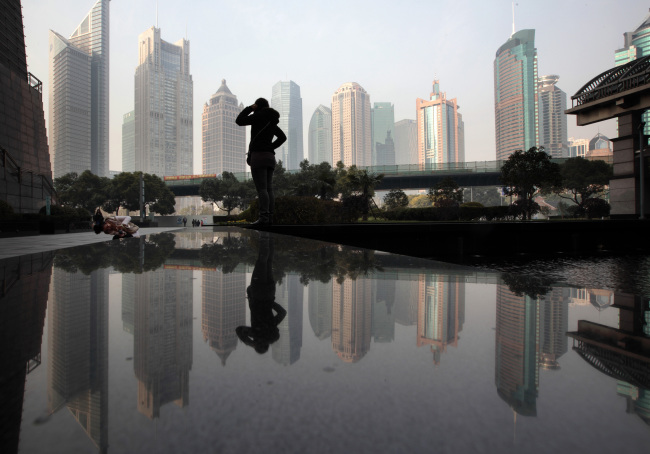BEIJING (AP) ― China’s economic growth decelerated in the final quarter of 2013 and appears set to slow further, adding to pressure on its leaders to shore up an expansion as they try to implement sweeping reforms.
 |
Source: China National Buraau of Statistics |
The world’s second-largest economy grew by 7.7 percent over a year earlier, down from previous quarter’s 7.8 percent, data showed Monday. Growth for the full year was 7.7 percent, tying 2012 for the weakest annual performance since 1999.
Those figures appeared to mask a much sharper deterioration during the three months ending in December. Factory output, exports and investment all weakened. Growth in factory output in the final three months of 2013 dropped to 1.8 percent from the previous period’s 2.2 percent rate.
“The economy is slowing quite rapidly. The slowdown has accelerated during the quarter,” said economist Dariusz Kowalczyk of Credit Agricole CIB.
That weakness might force Beijing to resort to state-led investment to support an expansion. That would boost debt levels that already have prompted unease about the health of China’s financial system and could hamper efforts to shift to more self-sustaining growth based on domestic consumption.
 |
Commercial buildings in the Pudong area of Shanghai. (Bloomberg) |
China’s growth still is far stronger than the United States, Japan or Europe. But an unexpectedly abrupt decline from the blistering double-digit rates of the previous decade has raised the risk of politically dangerous job losses and increases the challenges faced by the ruling Communist Party as it tries to rebalance the economy away from reliance on trade and investment.
“A long-term accumulation of problems has yet to ease and the foundation for economic stabilization and recovery is still consolidating,” said the commissioner of the government statistics bureau, Ma Jiantang, at a news conference.
A plunge in global demand for Chinese exports prompted Beijing to launch a mini-stimulus in mid-2013 based on higher spending on railway construction and other public works. Growth accelerated from 7.5 percent in the three months ending in June to 7.8 percent the next quarter but settled back as the effect of Beijing’s spending faded.
Since then, Chinese leaders have said there is little that additional stimulus can do to spur growth and improvements will have to come from longer-term reforms.
The International Monetary Fund has forecast this year’s growth at 7.6 percent but private sector forecasts are as low as 7.2 percent. That would be China’s weakest performance since 1990, when the economy grew by just 3.8 percent.
A development blueprint issued by the party leadership in November promises to open state-dominated industries wider to private and foreign competition and to give entrepreneurs who generate most of China’s growth and jobs a bigger economic role. However, it stressed that state ownership would remain a pillar of the economy.
The plan promises to allow foreign companies into industries such as e-commerce, accounting and logistics and to give Chinese entrepreneurs more opportunities. Regulators announced this month they will allow the creation of five privately financed banks this year. But such changes could take years to show an impact on China’s economic output.
More reliance on investment financed by government borrowing might add to strains on a financial system some analysts say could already be carrying dangerously high debt levels.
Heavy spending by Chinese cities and other local governments as part of Beijing’s stimulus in response to the 2008 global crisis and on social programs since then left them heavily indebted. An official audit released at the end of December showed the amount owed by cities and other local governments soared 70 percent over the past three years to 17.7 trillion yuan ($2.9 trillion) as of mid-2013.
The central bank has said the debt level is manageable but private sector analysts warn the rapid pace of increase is dangerous.
Growth for 2013 came in above the government’s 7.5 percent official target but data showed many areas of the economy slowing toward the end of the year.
Growth in factory output slowed to 9.7 percent in December from 10.3 percent in October, the first month of the quarter. Investment in factories, real estate and other fixed assets decelerated to 17.1 percent from 19.4 percent over the same period.
Growth in retail sales was steady but full-year retail sales growth of 13.1 percent was well below the 19.6 percent growth of investment, highlighting China’s reliance on spending on factories, highways and other assets.
“There is no rebalancing yet. Basically investment continues to be the key driver,” said Kowalczyk.
Analysts also noted that household income growth, though relatively strong at 9.7 percent last year, was lower than in previous years. That, coupled with an impending contraction of China’s workforce as the population ages, will hamper efforts to promote consumer spending.
“We estimate that the share of household consumption in GDP fell again in 2013,” said RBS economist Louis Kuijs in a report.









